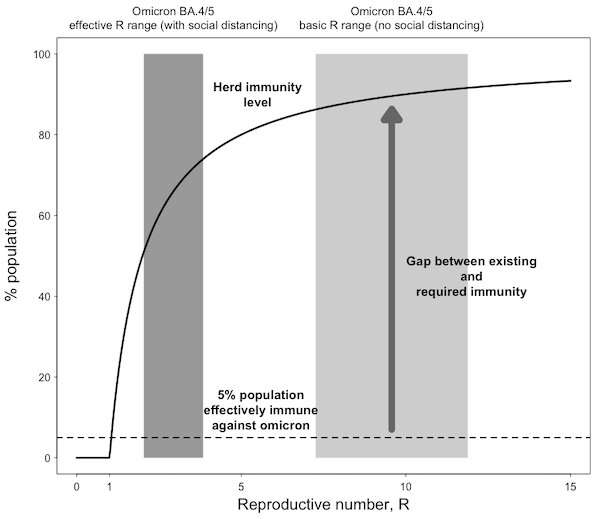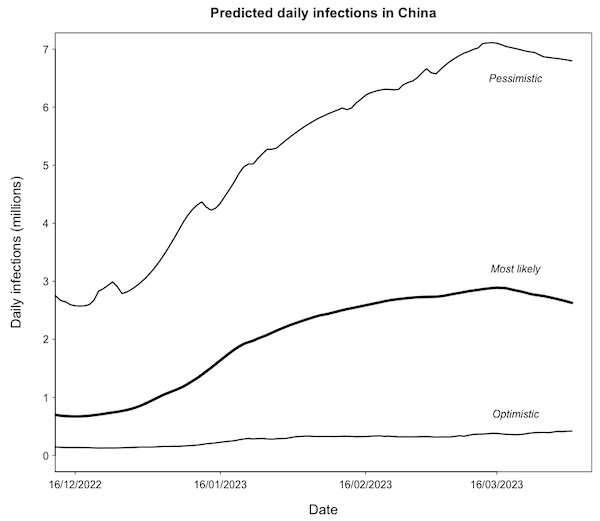This article has been reviewed according to Science X's editorial process and policies. Editors have highlighted the following attributes while ensuring the content's credibility:
fact-checked
trusted source
written by researcher(s)
proofread
COVID is running rampant in China—but herd immunity remains elusive

After nearly three years of keeping COVID under control, China is experiencing a massive new wave of COVID infections. The official figures reporting 60,000 deaths between December 8 and January 12 are widely seen as underestimating the impact of the outbreak.
Until December 2022, China had used lockdown policies to reduce the opportunity for COVID spread in the hope of eliminating the virus or building up enough population immunity through vaccination. The exceptionally strict zero-COVID policy was very successful in stopping the virus' spread while the world faced returning deadly waves.
However, the prolonged lockdowns eventually became politically and economically unsustainable. China's official policy is currently concentrating on strengthening the early detection and treatment of severe cases rather than the prevention of infections. This has led to claims the country is now pursuing a "herd immunity" approach.
But would this be a realistic goal? Lessons from other countries' experiences suggest not. Let's take a look at why.
Herd immunity: A recap
The herd immunity concept was introduced some 100 years ago to explain why epidemic waves often stop before affecting the whole population.
As a disease such as COVID spreads, more people become infected. Most of them recover and gain infection-induced immunity. Those who become infected increasingly have contact with immune rather than susceptible people. This leads to lower risk of passing on the infection.

The epidemic wave slows down and eventually declines. The decline is caused by a sufficiently large number of people becoming immune, therefore protecting the whole population—or the "herd". In the 1970s, epidemiologists found a simple formula that predicts the proportion of immune individuals at which the number of infections stops growing.
The formula includes the R number, the average number of people one infected person passes the disease onto. Non-pharmaceutical interventions, like social distancing, lockdowns, or mask-wearing, are aimed at reducing the transmissibility of the virus, lowering the value of R.
The herd immunity threshold also depends on the proportion of people with pre-existing immunity from either previous outbreaks or vaccination. Using these concepts, scientists have designed vaccination strategies that successfully keep contagious diseases such as smallpox, polio, diphtheria and rubella under control.
For such public health policies to be successful, mass vaccination needs to reach a high proportion of the population. Sublineages of the omicron variant BA.5 are currently dominant in China. Omicron has an average R of 9.5, so around 90% of the population needs to be fully protected to reach herd immunity, according to the model.
However, vaccination is not perfect. Some 89% of China's population has so far reportedly received two doses of the vaccine. But booster uptake is low and the efficacy of the Sinovac and Sinopharm vaccines used in China is lower than the mRNA vaccines from Pfizer and Moderna used widely. So, the actual percentage of people protected by the vaccine will be lower than in other countries—perhaps as low as 5%.
Before December 2022, China had seen relatively few COVID cases, leaving infection-induced immunity low. This creates a significant gap between the existing levels of immunity and those required to achieve herd immunity, as illustrated in the figure below. In the absence of other control measures, this gap will need to be filled in by infection, resulting in a massive outbreak.

Predictions are challenging
Predicting what will happen next in China is difficult due to the lack of reliable data. Although cases now seem to be decreasing, the traditional activity around the lunar new year will most likely cause a new wave.
Several models have explored different assumptions. The Institute for Health Metrics and Evaluation expects almost three million cases per day at an upcoming peak following the lunar new year and 1.6 million deaths by the end of 2023.
Health data analytics company Airfinity predicts four million cases per day at the peak of the upcoming wave, and that the number of deaths could reach 2.1 million. Given the uncertainty about the epidemic spread in China, these numbers might even be underestimates.
Eventually, China's population will temporarily reach the "herd immunity" level, and the upcoming wave will probably peak around March 2023, according to these models. But this is not a guarantee that the epidemic will end there.
The virus persists even in countries like the UK, where roughly 80%–95% of the population have COVID antibodies. This indicates high levels of immunity from prior infection, vaccination, or both.
Unfortunately, the immunity from COVID vaccines and prior infections wanes after some months and may be less durable against new variants. As a result, new waves appear as herd immunity is temporarily breached, before being restored again.
If China is really aiming at herd immunity to eliminate the virus—and some young Chinese people are apparently seeking infection—it will very likely fail again. The repeated lesson from other countries is that the loss of immunity and the appearance of new variants make herd immunity a futile goal when it comes to COVID.
This article is republished from The Conversation under a Creative Commons license. Read the original article.![]()



















